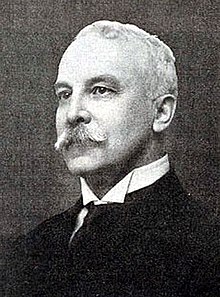Harrington Emerson
Harrington Emerson (born August 2, 1853 in Trenton , New Jersey, † September 2, 1931 in New York ) was an American business consultant and organizational theorist.
Life
Harrington Emerson was born to Edwin and Mary Louise Emerson.
He received his education in England, France, Germany, Italy and Greece. In 1870 he married Florence Brooke, with whom he had a son, Raffe.
From 1876 he headed the "Modern Language Department" at the University of Nebraska. In 1882 he left the university to work with his brother SDI Emerson in the banking and real estate sector. From 1885 to 1891 he did research for the Burlington Railroad.
In 1895 he married Mary Crawford Supple, with whom he had three daughters (Louise, Isabel and Margaret).
From 1895 to 1899 he was a representative of the "British Syndicate Investing" in America. At the same time, he investigated the finances and operations of many factories and mines in Mexico, the United States, and Canada.
From 1899 to 1901 he ran a glass factory.
From 1901 to 1907 he was an industrial and business consultant. From 1904 to 1907 he reorganized the Atchison, Topeka and Santa Fe railways . He led a bonus plan, standard cost, and accounting using tabs one. In addition, he planned maintenance of the equipment and rolling stock.
From 1907 to 1911 he was the key witness in the "Eastern rates case". In 1911 he was appointed to the "Civilian Expert Board on Industrial Management" of the US Navy shipyards to examine the operation and general conditions of the shipyards.
In 1921 he was appointed a member of the "Hoover Committee for the Elimination of Haste in Industry"; he worked on the coal and railroad sector. In 1929 he attended the "International Management Congress" in Paris.
He died on September 2, 1931, at the age of 78 in New York City.
meaning
Emerson works closely with Frederick Winslow Taylor and was one of the founders of Scientific Management .
Works
| personal data | |
|---|---|
| SURNAME | Emerson, Harrington |
| BRIEF DESCRIPTION | American manager and management theorist |
| DATE OF BIRTH | August 2, 1853 |
| PLACE OF BIRTH | Trenton , New Jersey, USA |
| DATE OF DEATH | September 2, 1931 |
| Place of death | New York City , New York, USA |
